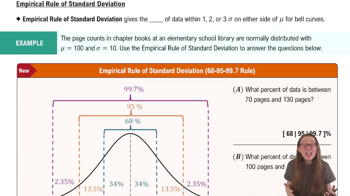Explain how to use a t-test to test a hypothesized mean mu when sigma is unknown. What assumptions are necessary?
Table of contents
- 1. Intro to Stats and Collecting Data1h 14m
- 2. Describing Data with Tables and Graphs1h 55m
- 3. Describing Data Numerically2h 5m
- 4. Probability2h 16m
- 5. Binomial Distribution & Discrete Random Variables3h 6m
- 6. Normal Distribution and Continuous Random Variables2h 11m
- 7. Sampling Distributions & Confidence Intervals: Mean3h 23m
- Sampling Distribution of the Sample Mean and Central Limit Theorem19m
- Distribution of Sample Mean - Excel23m
- Introduction to Confidence Intervals15m
- Confidence Intervals for Population Mean1h 18m
- Determining the Minimum Sample Size Required12m
- Finding Probabilities and T Critical Values - Excel28m
- Confidence Intervals for Population Means - Excel25m
- 8. Sampling Distributions & Confidence Intervals: Proportion1h 25m
- 9. Hypothesis Testing for One Sample3h 57m
- 10. Hypothesis Testing for Two Samples4h 50m
- Two Proportions1h 13m
- Two Proportions Hypothesis Test - Excel28m
- Two Means - Unknown, Unequal Variance1h 3m
- Two Means - Unknown Variances Hypothesis Test - Excel12m
- Two Means - Unknown, Equal Variance15m
- Two Means - Unknown, Equal Variances Hypothesis Test - Excel9m
- Two Means - Known Variance12m
- Two Means - Sigma Known Hypothesis Test - Excel21m
- Two Means - Matched Pairs (Dependent Samples)42m
- Matched Pairs Hypothesis Test - Excel12m
- 11. Correlation1h 24m
- 12. Regression1h 50m
- 13. Chi-Square Tests & Goodness of Fit2h 21m
- 14. ANOVA1h 57m
9. Hypothesis Testing for One Sample
Steps in Hypothesis Testing
Problem 11.R.13de
Textbook Question
In Exercises 13 and 14, (d) decide whether to reject or fail to reject the null hypothesis, and (e) interpret the decision in the context of the original claim.
Use
[APPLET] A highway patrol officer stops speeding vehicles on an interstate highway. The genders of the last 25 drivers who were stopped are shown, where F represents a female driver and M represents a male driver. Can you conclude that the stops were not random by gender?
F M M M F M F M F F F M M
F F F M M M F M M F F M
 Verified step by step guidance
Verified step by step guidance1
Step 1: Define the null hypothesis (H₀) and the alternative hypothesis (H₁). H₀: The stops are random by gender (proportion of males and females is equal). H₁: The stops are not random by gender (proportion of males and females is not equal).
Step 2: Calculate the observed frequencies of males (M) and females (F) from the data. Count the number of M's and F's in the given sequence.
Step 3: Determine the expected frequencies under the null hypothesis. If the stops are random, the expected frequency for each gender is (total number of stops) × (0.5), assuming equal probability for males and females.
Step 4: Perform a chi-square goodness-of-fit test. Use the formula χ² = Σ((Oᵢ - Eᵢ)² / Eᵢ), where Oᵢ is the observed frequency and Eᵢ is the expected frequency for each category (male and female).
Step 5: Compare the calculated χ² value to the critical value from the chi-square distribution table at the appropriate significance level (e.g., α = 0.05) and degrees of freedom (df = number of categories - 1). Decide whether to reject or fail to reject H₀ based on this comparison, and interpret the result in the context of the problem.
 Verified video answer for a similar problem:
Verified video answer for a similar problem:This video solution was recommended by our tutors as helpful for the problem above
Video duration:
3mPlay a video:
Was this helpful?
Key Concepts
Here are the essential concepts you must grasp in order to answer the question correctly.
Null Hypothesis
The null hypothesis is a statement that there is no effect or no difference, and it serves as the default assumption in hypothesis testing. In this context, it posits that the gender distribution of the stopped drivers is random, meaning that the proportion of male and female drivers stopped is consistent with the overall population. Testing this hypothesis involves statistical analysis to determine if observed data significantly deviates from what would be expected under this assumption.
Recommended video:
Guided course

Step 1: Write Hypotheses
Statistical Significance
Statistical significance refers to the likelihood that a relationship observed in data is not due to random chance. In hypothesis testing, a result is considered statistically significant if the p-value is less than a predetermined threshold (commonly 0.05). This concept is crucial for deciding whether to reject the null hypothesis, as it indicates whether the observed gender distribution in the stops is unlikely to have occurred if the null hypothesis were true.
Recommended video:
Guided course

Parameters vs. Statistics
Interpretation of Results
Interpreting results involves explaining the implications of the statistical analysis in the context of the original claim or research question. After deciding whether to reject or fail to reject the null hypothesis, it is essential to articulate what this decision means in practical terms. For instance, if the null hypothesis is rejected, it suggests that the stops were not random by gender, which could have implications for law enforcement practices and gender bias.
Recommended video:

Empirical Rule of Standard Deviation and Range Rule of Thumb

 5:12m
5:12mWatch next
Master Intro to Hypothesis Testing with a bite sized video explanation from Patrick
Start learningRelated Videos
Related Practice
Textbook Question
33
views
